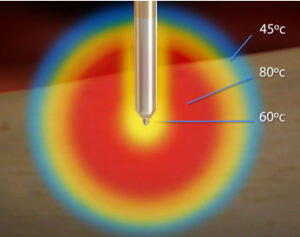The cervical region, located in the upper spine and the neck, supports the head and assists in head and neck mobility. In the United States, 30 to 50 percent of adults experience neck pain, the majority of which originates from mechanical injury, such as whiplash.1 25 to 45 percent of chronic neck pain cases come from the facet joints.2
Limitations of Conventional Management Options
- Physical therapy and massage are unable to provide long-term analgesic benefit
- Intraarticular steroid injections for cervical facet joint pain have yielded disappointing results3
 Advantages of Using COOLIEF* Cooled Radiofrequency
Advantages of Using COOLIEF* Cooled Radiofrequency
COOLIEF* Cooled RF is a minimally invasive procedure that ablates the nerves sending pain signals from the facet joint to the brain for up to 24 months.4 COOLIEF* Cooled RF is proven to be safe and effective for both patients seeking less-invasive pain relief intervention and those who are not appropriate candidates for surgery.
Specifically designed to treat complex anatomy of variable nerve courses, COOLIEF* Cooled RF uses water-cooled technology that enables more RF energy to safely deactivate pain-transmitting sensory nerves. This creates a larger, spherical lesion that distally projects 45% or greater beyond the probe’s tip.
Evaluating CRFA in Treatment of Cervical Pain
A 2020 cross-sectional cohort study published in Pain Medicine evaluated the long-term efficacy of CRFA in cervical pain treatment. Researchers analyzed the treatment outcomes of 50 subjects who received CRFA for cervical pain. Subjects were evaluated for pain, quality of life and safety at either six to 12, 12 to 24, or >24 months using the NRS and PGIC. The primary endpoint of this study was the number of subjects whose cervical pain was reduced ≥50 percent from baseline.
Percentage of Patients that Experienced ≥50% of Pain Relief

Across all interval groups, 54% of subjects experienced ≥50% pain relief, with a mean reduction of 3.1 points from baseline in the NRS.
In the 6-to-12 month interval group, 47% of subjects reported ≥50% pain relief. In the 12-to-24 month interval group 54% of subjects reported ≥50% pain relief.
In the >24 month interval group, 63% of subjects reported ≥50% pain relief.
Overall, 70% of subjects reported a PGIC score consistent with an “improved” or a “very much improved” condition from baseline.
Key Takeaway: CRFA is an effective and durable treatment for chronic cervical pain through 24 months.

Click here for Instructions for Use
References:
- Manchikanti L, Hirsch JA, Kaye AD, et al. Cervical zygapophysial (facet) joint pain: effectiveness of interventional management strategies. Postgrad Med. 2016;128(1):54-68.
- Manchikanti L, Boswell MV, Singh V, et al. Prevalence of facet joint pain in chronic spinal pain of cervical, thoracic, and lumbar regions. BMC Musculoskelet Disord. 2004;5:15.
- Cohen SP, Huang JH, Brummet C. Facet joint pain-advances in patient selection and treatment. Nature Reviews Rheumatology. 2013;9(2):101-16.
- Burnham T, Conger A, Salazar F, et al. The effectiveness of cervical medial branch radiofrequency ablation for chronic facet joint syndrome in patients selected by a practical medial branch block paradigm. Pain Med. 2020; 21(10):2071-2076

 Advantages of Using COOLIEF* Cooled Radiofrequency
Advantages of Using COOLIEF* Cooled Radiofrequency